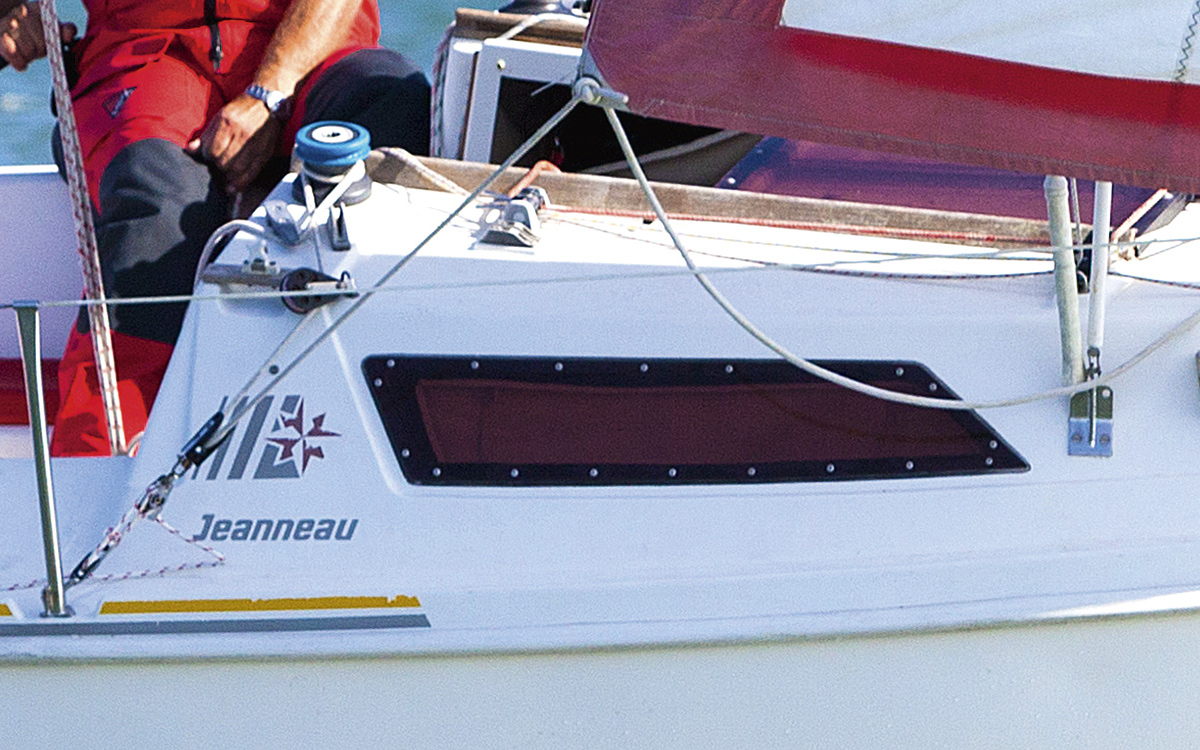David Bond gets professional tips for prolonging the life of his boat sails
Boat sails: how to make them last longer
This is what every cruiser needs,” says Kristina Damijanidis, as she picks up a Speedy Stitcher Sewing Awl. A Speedy Stitcher?
I know I have one of these hand tools somewhere in my ditty bag, but even if you offered me £50, I don’t think I could put my hand on it.
Kristina and her partner, Giuseppe Della Volpe, are professional sailmakers who operate their Rolly Tasker sail loft in Gran Canaria, Spain.
She recommends the Speedy Stitcher for quick fixes like adding patches while underway. “At sea, you have to find a needle, a palm. With this, everything is ready.”

The Speedy Stitcher Sewing Awl was invented in 1909. Credit: Speedy Stitcher
She hands it to me; the tool, with its wooden handle and diamond point needle hasn’t changed much in the last 100 years.
“This is also very good for when you don’t have a sewing machine. You can apply more pressure with the wooden handle than you can with a needle and thread. And it’s easier to use.”
She turns to find some patching material, then shows me her stitching technique.
I’m in their Las Palmas sail loft, MDV Sailmakers, a brightly lit room with six sewing machines and a long layout table dominating the floor.
It’s a business that Giuseppe and Kristina have built from the ground up during difficult times.

Kristina Damijanidis and Giuseppe Della Volpe cruised extensively before setting up their sail loft in Gran Canaria. Credit: David Bond
Even with the Covid-19 lockdown, the masks, and the police repeatedly patrolling the empty streets, Giuseppe and Kristina not only managed to keep their business afloat, they found a way to make it thrive.
During the height of the pandemic, Giuseppe set up his sewing machine in the cockpit of his 40ft liveaboard ketch.
Since no one was sailing anywhere, yacht owners used the downtime to upgrade their boat sails and gear.
“People would stop on the dock and ask me if I could do this or that, so I gave them my email address.”
Continues below…
DIY Sail repairs – how to do a ‘get you home’ repair
Ben Meakins tries out some useful temporary sail repair methods that will tide you over until you can get to…
Refining rigging and improving performance
Sometimes you have to be cruel to be kind. When, back in 2014, I saw the mainsail on Peter Kewish’s…
Stop genoa sheets catching when tacking
Peter Lyle stops lines snagging on a stored spinnaker pole when tacking his Jeanneau 36i
Basic sewing skills for boat owners to protect sails from chafe
Chafe damage has always been a problem on yachts, and owners are generally advised to preserve their sails by adding…
Business picked up, and Giuseppe found a clever way to complete the sail repairs and deliver them to his customers, without the need for physical contact.
“They would write me an email detailing what they wanted, and I’d give them a quote for the job. Then, they’d leave the sail on the front seat in the jeep. After the repair was done, I would put the sail back in the jeep, email the customer, and ask them to put the payment under the floor mats. No one else was on the streets except the police. It worked.”
Once the pandemic restrictions had subsided, Giuseppe and Kristina rented enough space for MDV Sailmakers.
Making boat sails to last
Giuseppe unrolls the clew of a Dacron genoa and points to a long strip of sail tape radiating from the clew ring.
It’s a heavy clew from an offshore cruising boat. There are several layers of sailcloth and stitching. The grey leather is cracked and torn away in places.
“The genoa is a simple sail, and there are two important places on it. One is the luff. You need chafe protection and sun protection there, but the other is the clew.”

Longer clew tape can lengthen the life of a headsail. Credit: Rolly Tasker
People forget to reinforce the clew. “When the sail is new, everything is all right, but after a few years the stress comes.”
He traces the line of a long tape projecting from the clew ring, angling towards the luff. “You need a longer tape here for reinforcement against the constant stress.”
He re-rolls the sail. “These are things you can ask the sailmaker to include when the sail is new – especially for offshore sailing, but also for coastal sailing.”
Safety in numbers
Additional reefs are another good investment, and might save you the expense of a storm sail.
Giuseppe unrolls the head of a golden Kevlar mainsail.
“This sail has an extra set of reef points. A third reef that acts like a fourth, a deep reef,” he says. “This customer sails in the powerful winds of the western Canary Islands with a reefed main.”
This sail has that third, deeper reef for safety.
Twist and shout
Giuseppe takes out his phone to show me the photo of a splintered, spiky end of a forestay.
“Too much pressure,” he says as he shakes his head. “People don’t realise how much force they can put on a headstay when they furl a stuck genoa.”
Sometimes the sail gets jammed, or the halyard wraps around the forestay, especially on boats with electric winches where you don’t feel the pressure. The result can be devastating.

A headsail wrap can lead to headstay failure. Credit: coneng.co.uk
He refers to another photo where the sailor had put the furling line to a winch, then cranked and forced the genoa to furl, not knowing that a slack halyard had wrapped around the forestay.
“So, he was turning and turning the forestay, and what happened? He twisted the stainless steel cable right out of its terminal fitting. The boat wasn’t that old, and the owners were experienced sailors. People get tired and just want to get into harbour.”
Finesse, not force, is the key to safety.
“You must have a feel for the sail, for the furling line. If it gets stuck, stop! Look for the problem. Don’t just keep trying to force it in. You could break the mast. And on this point, remember: electric winches are very strong,” says Giuseppe, who spent more than 20 years as a professional yacht skipper, mainly in the Mediterranean, before opening up his sail loft.
Perfect patches
According to Giuseppe, the secret to making a long-lasting patch is threefold:
- Thoroughly clean the sailcloth
- Glue in a small piece of light sailcloth under the adhesive patch
- Most of all, thoroughly roll the adhesive patch to get out all the air bubbles.
He picks up a smooth, heavy piece of metal that looks like the bottom of a spoon.

Durable self-adhesive sail cloth which is sewn down can help make old sails last longer. Credit: David Bond
“You must start from one end and lay down the patch,” he says as he removes the protective backing from the Insignia adhesive fabric.
He slowly covers the hole, constantly rubbing the fabric as he goes. “If there is air underneath, then soon there will be water, too, and the patch will let go.”
Memory is indelible
Modern carbon fibre sailcloth is lightweight and holds its shape, but it does have an Achilles heel: repeated folds.
“People treat their carbon sails like Dacron, but that’s a mistake. Carbon sails have a memory,” Giuseppe warns.
He unrolls another sail, this time revealing long cracks and complete breaks in the laminate.
He advises rolling the sails, not flaking them as most people do. Repeated folds in the same place will break down the laminate.
Chafe challenges
Sailmakers agree that chafe can be a major problem for cruising sailors.
One solution lies with the halyard. “Moving the halyard regularly will help ease wear on the same location on both the sail and the halyard,” recommends another sailmaker, Jeremy Smart, from North Sails in the UK.
Jeremy is also an advocate for spreader patches.
“Full length spreader patches that run right from the sail luff to 7in or 8in beyond the spreader tips are a good idea. They’ll protect both the spreader ends and the spreaders themselves.”
A choppy passage creates a lot of chafe on the rigging and the sails, so it’s important to make sure spreader patches are in the right location and full length.

Downwind sailing creates prime chafe conditions; this is exacerbated in chop or crossed seas. Credit: North Sails
A sailmaker can retrofit a sail with full length spreader patches; it can also be worth asking for patches for the first and second reefs.
“Patches are normally made from a durable self-adhesive sail cloth, but most likely they’ll need to be sewn down too – particularly on an old sail – to keep them firmly in place.”
Jeremy also suggests wrapping the spreaders with insulation and duct tape or leather.
Although it may not look great it can at least protect the sails on a long voyage, he says.
Since many cruisers still use whisker poles to wing out their genoa downwind, it’s important to eliminate chafe on the sail, the pole and its lines.
“Get the pole in the right place and the sail performs better,” says Bob Meagher from North Sails, US.
The correct placement and tension will also cut down on chafe. “Pick the spot that balances the pressure on the leech and foot, and gives as much sail projection as possible.”
Made to measure spreader patches
To achieve effective spreader patches takes careful measuring.
To do this, wait for a calm day. With the sail hoisted and eased right out onto the spreaders, hoist a crewmember aloft to mark the correct locations at the luff and leech ends.
Don’t forget to measure the spreaders too.
These measurements will give you the proper length for your sail patch.
For the best protection, most sailmakers recommend that both spreaders and sails need chafe protection.
Listen to your boat sails
Back in Giuseppe’s sail loft, he puts a hand on my shoulder. “You asked how to know when it’s time to get a new sail,” he says.
He picks up a fold from a Kevlar sail on the table and shakes it.

Dacron is long lasting and is a popular choice for cruising sailors. Credit: David Harding
There’s a loud, rattling, rumbling sound. A little like thunder. “Hear that? That’s the sound of a good sail. When you no longer hear anything that means the resin inside is gone, and the Kevlar sail loses its structural form. Maybe three years.”
Although he likes Kevlar, he believes Dacron is the better choice for the thrifty, long-distance cruising sailor.
Don’t forget the dinghy “People forget to cover their inflatable dinghy. Yes, they’re made of Hypalon, and that’s the best material for an inflatable, but after three years in the sun, it begins to break down.”
The tell-tale sign? “Little grey lines. When you start to see little grey lines in the material, that is the sign that it is deteriorating.”
A simple dinghy cover will slow down the damage.
Enjoyed reading Boat sails: how to make them last longer?
A subscription to Practical Boat Owner magazine costs around 40% less than the cover price.
Print and digital editions are available through Magazines Direct – where you can also find the latest deals.
PBO is packed with information to help you get the most from boat ownership – whether sail or power.
-
-
-
- Take your DIY skills to the next level with trusted advice on boat maintenance and repairs
- Impartial in-depth gear reviews
- Practical cruising tips for making the most of your time afloat
-
-








